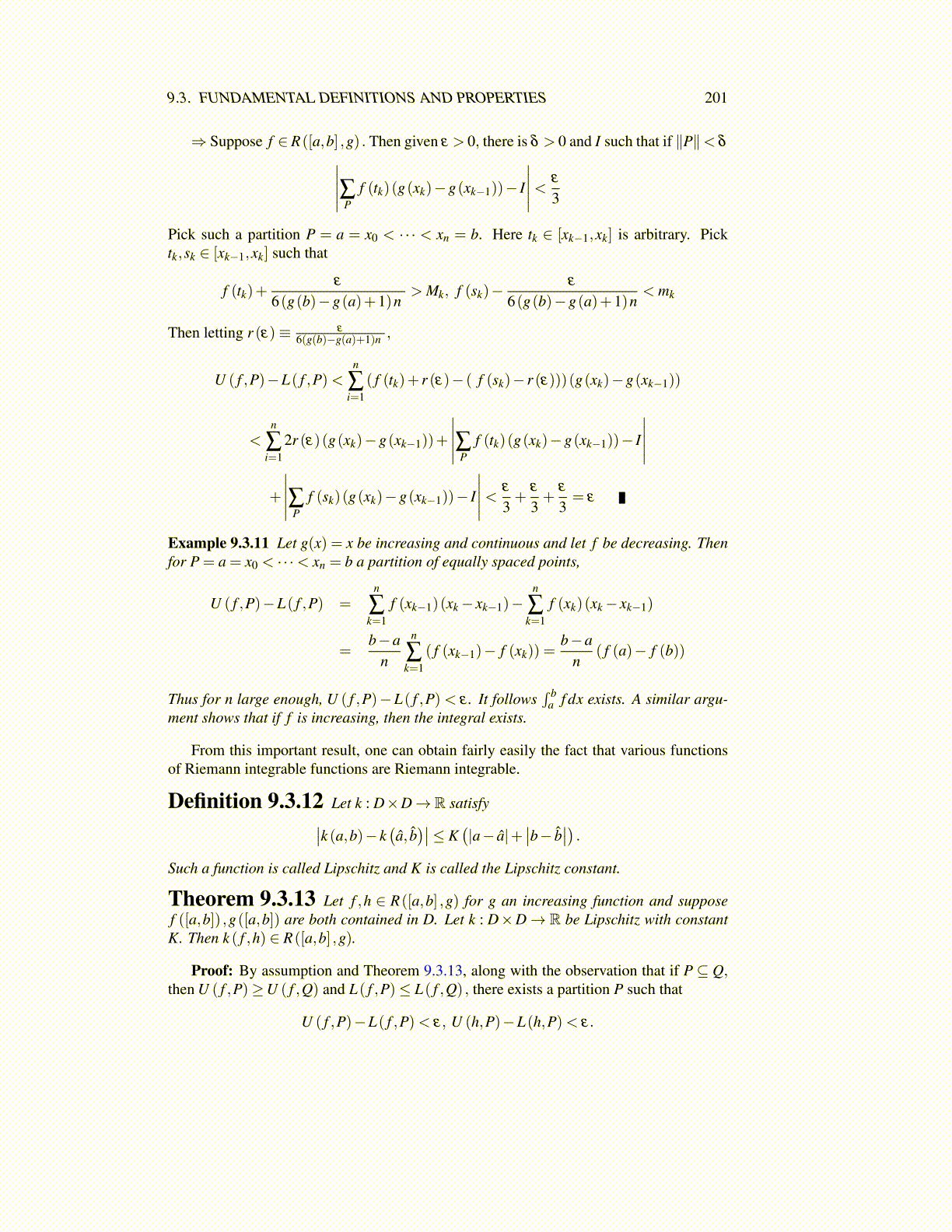
9.3. FUNDAMENTAL DEFINITIONS AND PROPERTIES 201
This is possible because either f or g is continuous at ci. Note there are at most r of theseintervals. The validity of the above inequality only depends on
∥∥P̃∥∥ so to eliminate possible
cases, assume that none of the yi equal any of the finitely many points in the list exceptpossibly yn and y0 if there is a discontinuity at an end point. Then there are m≤ r+1 closedintervals
{I j}m
j=1 which remain, other than these special ones which contain an exceptionalpoint and on each of these intervals, f is continuous. Hence denoting as U ( f ,Pj) an uppersum corresponding to a partition Pj of I j and L( f ,Pj) defined similarly, we can choose Pjon I j such that U ( f ,Pi)−L( f ,Pj)<
ε
5(r+1) . Letting P be a partition of [a,b] consisting ofthe yk along with the points of each Pj, it follows that
U ( f ,P)−L( f ,P)<m
∑j=1
(U ( f ,Pi)−L( f ,Pj))+ r (Mk−mk)(g(yk)−g(yk−1))
≤ ε
5(r+1)m+
ε
5<
2ε
5< ε
Proposition 9.3.16 Suppose f ∈R([a,b] ,g) where g is an increasing function. If f = f̂except at finitely many points {z1, · · · ,zn} at which g is continuous, then f̂ ∈R([a,b] ,g) and∫
f̂ dg =∫
f dg.
Proof: By assumption, there exists P such that U ( f ,P)−L( f ,P)< ε
4 . Then by addingin more points to P by including points on either side of the exceptional points and using thecontinuity of g at these exceptional points, we can pick these extra points close enough tothe exceptional points such that if P̂ consists of the new partition with the new points addedin,∣∣U ( f̂ , P̂
)−U ( f ,P)
∣∣< ε
4 and∣∣L( f̂ , P̂
)−L( f ,P)
∣∣< ε
4 . Therefore, U(
f̂ , P̂)−L(
f̂ , P̂)<
3ε
4 showing that f̂ is also in R([a,b] ,g) . Also, the two integrals are between all upper andlower sums. Thus these integrals are equal because if
∫f̂ dg≥
∫f dg,∣∣∣∣∫ f̂ dg−
∫f dg∣∣∣∣≤U
(f̂ , P̂)−L( f ,P)≤U
(f̂ , P̂)−L
(f̂ ,P)+
ε
4< ε
Since ε is arbitrary, this shows the two are equal. It works the same if∫
f dg≥∫
f̂ dg.In case g(x) = x so you are considering the Riemann integral, this theorem is more gen-
eral than the one which says that piecewise continuous functions are Riemann integrable.It is more general because you could have a function which is continuous except at finitelymany points but maybe the limit of the function from one side or another does not evenexist. A piecewise continuous function is defined next.
Definition 9.3.17 A bounded function f : [a,b]→R is called piecewise continuousif there are points zi such that a = z0 < z1 < · · · < zn = b and continuous functions gi :[zi−1,zi]→ R such that for t ∈ (zi−1,zi) ,gi (t) = f (t).
I think that the case of piecewise continuous functions is certainly the case of mostinterest, however. What happens is that the right and left limits of f exist at each of theexceptional points. Thus we can speak of
limx→zi+
f (x)≡ f (zi+) , and limx→zi−
f (x)≡ f (zi−)
where the first limit is taken from the right and the second limit from the left. On [zi−1,zi] ,the function gi equals f except at the endpoints it is the right or left limit of f .